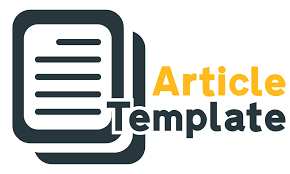POTENSI TANAMAN TRANSGENIK SEBAGAI SALAH SATU TEKNOLOGI DALAM PENGELOLAAN HAMA TERPADU
Sari
Teks Lengkap:
Download PDFReferensi
Agne, S., H. Waibel, & F. Fleischer.1995. Guidelines for pesticide policy studies: A framework for analyzing economic and political factors of pesticide use in developing countries. Publication Series 1. Hannover: Pesticide Policy Project.
Agustian, A., & Rachman, B. (2009). Penerapan teknologi pengendalian hama terpadu pada komoditas perkebunan rakyat. Prespektif, 8(1), 30–41.
Amirhusin, B. (2000). Peranan dan Potensi Dietary Insecticidal Protein dalam Rekayasa Genetika Tanaman Tahan Hama. Buletin AgroBio, 3(2), 74–79.
Amirhusin. B. (2002. Penggunaan Bacillus thuringiensis sebagai bioinsektisida. Buletin AgroBio 5(1): 21-28
Azimi, S., Rahmani, S., Tohidfar, M., Ashouri, A., Bandani, A., & Talaei-Hassanlouei, R. (2014). Interaction between Bt-transgenic cotton and the whitefly’s parasitoid, Encarsia formosa (Hymenoptera: Aphelinidae). Journal of Plant Protection Research, 54(3), 272–278. https://doi.org/10.2478/jppr-2014-0041
Bakhsh, A., Khabbazi, S. D., Baloch, F. S., Demirel, U., Çalişkan, M. E., Hatipoğlu, R., Özcan, S., & Özkan, H. (2015). Insect-resistant transgenic crops: Retrospect and challenges. Turkish Journal of Agriculture and Forestry, 39(4), 531–548. https://doi.org/10.3906/tar-1408-69
Bashir, K., Husnain, T., Fatima, T., Latif, Z., Aks Mehdi, S., & Riazuddin, S. (2004). Field evaluation and risk assessment of transgenic indica basmati rice. Molecular Breeding, 13(4), 301–312. https://doi.org/10.1023/B:MOLB.0000034078.54872.25
Bent, A. F., & Yu, I. ching. (1999). Applications of Molecular Biology to Plant Disease and Insect Resistance. Advances in Agronomy, 66(C), 251–298. https://doi.org/10.1016/S0065-2113(08)60429-0
Bigler, F., Meissle, M., & Romies, J. (2013). Genetically modified crops in Integrated Pest Management. Agroscope ART Zurich, Switzerland, 1–33. South Asia Biosafety Conference, New Delhi, 18-20 September 2013
Cahyadi, F. 2006. Dampak Lingkungan Tanaman Transgenik. http://www.satudunia.net/node/1178. Diakses tanggal: 10 April 2009
Christou, P., Capell, T., Kohli, A., Gatehouse, J. A., & Gatehouse, A. M. R. (2006). Recent developments and future prospects in insect pest control in transgenic crops. Trends in Plant Science, 11(6), 302–308. https://doi.org/10.1016/j.tplants.2006.04.001
FAO. 2015. Genetically Modified Crops. Food and Agriculture Organization. http;//www.fao.org/docrep/015/i2490e04d.pdf. Diakses 22 Februari 2016
Gebhard, F., & Smalla, K. (1999). Monitoring field releases of genetically modified sugar beets for persistence of transgenic plant DNA and horizontal gene transfer. FEMS Microbiology Ecology, 28(3), 261–272. https://doi.org/10.1016/S0168-6496(98)00115-9
Hardke, J. T., Leonard, B. R., Huang, F., & Jackson, R. E. (2011). Damage and survivorship of fall armyworm (Lepidoptera: Noctuidae) on transgenic field corn expressing Bacillus thuringiensis Cry proteins. Crop Protection, 30(2), 168–172. https://doi.org/10.1016/j.cropro.2010.10.005
Herman, M. (2002). Perakitan Tanaman Tahan Serangga Hama melalui Teknik Rekayasa Genetik. Buletin AgroBio, 5(1), 1–13.
Hoy, C., Feldman, J., Gould, F., Kennedy, G., Reed, G., & Wyman, J. (1998). Naturally occurring biological controls in genetically engineered crops. Conservation Biological Control, 185–205. https://doi.org/10.1016/b978-012078147-8/50056-6
Kos, M., van Loon, J. J. A., Dicke, M., & Vet, L. E. M. (2009). Transgenic plants as vital components of integrated pest management. Trends in Biotechnology, 27(11), 621–627. https://doi.org/10.1016/j.tibtech.2009.08.002
Kruger, M., Van Rensburg, J. B. J., & Van den Berg, J. (2009). Perspective on the development of stem borer resistance to Bt maize and refuge compliance at the Vaalharts irrigation scheme in South Africa. Crop Protection, 28(8), 684–689. https://doi.org/10.1016/j.cropro.2009.04.001
Kusnaedi. 2001. Pengendalian Hama Tanpa Pestisida. Jakarta.Penebar Swadaya.
Nandi, A. K., Basu, D., Das, S., & Sen, S. K. (1999). High level expression of soybean trypsin inhibitor gene in transgenic tobacco plants failed to confer resistance against damage caused by Helicoverpa armigera. Journal of Biosciences, 24(4), 445–452. https://doi.org/10.1007/BF02942655
Naranjo, S. E. (2011). Impacts of Bt transgenic cotton on integrated pest management. Journal of Agricultural and Food Chemistry, 59(11), 5842–5851. https://doi.org/10.1021/jf102939c
Nordlee, J. A., Taylor, S. L., & Townsend, J. A. (1996). Identification of a brazil-nut allergen in transgenic soybeans. Pneumologie, 50(6), 401. https://doi.org/10.1056/nejm199603143341103
Phillips, S.C. 1994. Genetically engineered foods: do they pose health and environmental hazards?. CQResearcher, 4(29): 673–96.
Rachmat, A., A. Nurawan, & T. Subarna. 1999. Pengendalian Hama Terpadu Pada Teh Rakyat di Jawa Barat. BPTP Jawa Barat, Bandung. hal 57.
Ramalho, F. S., Pachú, J. K. S., Lira, A. C. S., Malaquias, J. B., Zanuncio, J. C., & Fernandes, F. S. (2014). Feeding and dispersal behavior of the cotton leafworm, Alabama argillacea (Hübner) (Lepidoptera: Noctuidae), on Bt and non-Bt cotton: Implications for evolution and resistance management. PLoS ONE, 9(11). https://doi.org/10.1371/journal.pone.0111588
Santosa, D.A. 2000. Analisis Resiko Lingkungan Tanaman Transgenik. Jurnal Ilmu Tanah dan Lingkungan 3(2): 32-36
Schuler, T. H., Poppy, G. M., Kerry, B. R., & Denholm, I. (1999). Potential side effects of insect-resistant transgenic plants on arthropod natural enemies. Trends in Biotechnology, 17(5), 210–216. https://doi.org/10.1016/S0167-7799(98)01298-0
Sears, M. K., Hellmich, R. L., Stanley-horn, D. E., Oberhauser, K. S., Pleasants, J. M., Mattila, H. R., Siegfried, B. D., & Dively, G. P. (2001). Impact of Bt corn pollen on monarch butterfly populations: A risk assessment Mark. Proceedings of the National Academy of Sciences of the United States of America, 98(21), 11937–11942. https://doi.org/www.pnas.org/cgi/doi/10.1073/pnas.211329998
Sharma, H.C. 2009. Biotechnological Approaches for Pest Management and Ecological Sustainability. CRC Press, Taylor & Francis group. New York.
Singh, O. V., Ghai, S., Paul, D., & Jain, R. K. (2006). Genetically modified crops: Success, safety assessment, and public concern. Applied Microbiology and Biotechnology, 71(5), 598–607. https://doi.org/10.1007/s00253-006-0449-8
Small, B. H., Parminter, T. G., & Fisher, M. W. (2005). Understanding public responses to genetic engineering through exploring intentions to purchase a hypothetical functional food derived from genetically modified dairy cattle. New Zealand Journal of Agricultural Research, 48(4), 391–400. https://doi.org/10.1080/00288233.2005.9513672
Tabashnik, B. E., Dennehy, T. J., & Carrière, Y. (2005). Delayed resistance to transgenic cotton in pink bollworm. Proceedings of the National Academy of Sciences of the United States of America, 102(43), 15389–15393. https://doi.org/10.1073/pnas.0507857102
Trisyono, Y.A., Rahayu, S.T.S., & St Margino. 2004. Bioactivity of Bacillus thuringiensis Cry 1Ac Toxin to Spodoptera litura. Jurnal Perlindungan Tanaman Indonesia 10(1): 53-62
Untung, K. 2006. Pengantar Pengelolaan hama Terpadu (edisi kedua). Gadjah Mada University Press. Yogyakarta
Young, A. L., & Lewis, C. G. (1995). Biotechnology and potential nutritional implications for children. Pediatric Clinics of North America, 42(4), 917–930. https://doi.org/10.1016/S0031-3955(16)40022-2
Yu, H., Li, Y., Li, X., Romeis, J., & Wu, K. (2013). Expression of Cry1Ac in transgenic Bt soybean lines and their efficiency in controlling lepidopteran pests. Pest Management Science, 69(12), 1326–1333. https://doi.org/10.1002/ps.3508
Refbacks
- Saat ini tidak ada refbacks.








